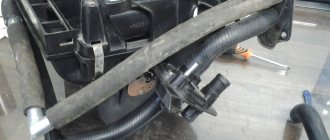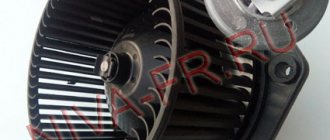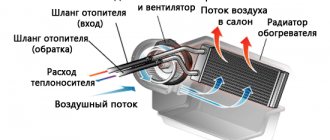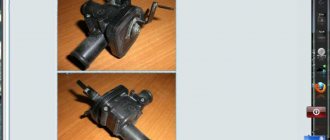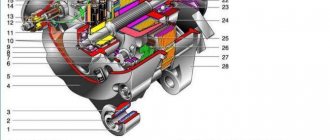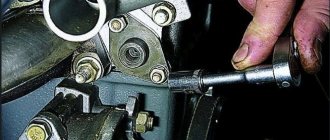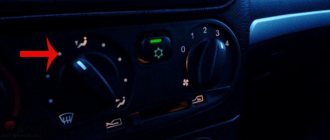Modifying the Niva Chevrolet stove - 2 simple ways
The operation of the Niva Chevrolet (and now Lada Niva) heater does not suit all owners of this SUV.
It doesn't blow well into your feet and you can't adjust the air flow so that it blows into your feet and onto the windshield. To solve these problems, the owners proposed two simple modifications to the stove that you can do yourself. Remove the sector of the damper drive levers (bar)
:
- Remove the tunnel lining in the driver's feet by unscrewing 5 screws.
- Disconnect the cable, unscrew the two screws and remove the plastic bar that regulates the operation of the dampers.
Chevrolet Club - Information
First of all, check the flow in the expansion tank at idle. There should be a vigorous flow. If there is no stream, then throw the pump in the trash. The pump must be original, no cheap one will do, it has a smaller impeller. With a non-original or faulty pump, a stream appears in the tank only when you re-gas it.
Pump and test. Lech wrote:. Good day everyone! I would also like to make my small contribution to the forum if, of course, anyone else is interested. Not long ago I had problems with the heater which I solved by replacing the pump. If I posted the topic incorrectly, please correct me.
The essence of my problem was that with the engine well warmed up, the temperature in the cabin left much to be desired. The strong air flow from the heater was lukewarm. Thanks to the respected forum participants, the decision was made to change the pump. Indeed, in my case, the stream in the reservoir at idle was completely absent, appearing only closer to the engine speed. Having removed the pump, it turned out that there was a “hepa” with a small impeller:. The hepa impeller has a diameter of 64mm. The TZA impeller has a diameter of 72mm.
Measuring the air temperature from the heater in the glass mode with a well-warmed engine before replacing the pump showed the following result: After replacing the pump with the original one, a steady stream appeared in the expansion tank at idle speed and the heater air temperature in the same mode on the glass increased significantly: Now I I felt warm, I even unscrew the heat-cold knob to 12 hours, otherwise it’s too hot..
Participants online
If the motorist nevertheless decides to replace the resistor on his own, then he should pay attention to the procedure given below: The fastenings of the glove compartment should be loosened, after which it can be moved forward a little. There is no need to completely remove the glove compartment. It is best to use a small Phillips head screwdriver for this manipulation. A dimensional analogue of the tool will not help in this situation, since the space for maneuver will be limited.
Causes of poor stove performance
Next, you need to disconnect the resistor from the power supply. To do this, you just need to pull the terminals out of it.
Then unscrew the screw securing it. The new resistor is installed in the reverse order of dismantling the faulty analogue. Immediately after connecting the resistor, it is necessary to test the functionality of the stove.
This will help identify possible connection problems. Repairs should only be continued after a successful test.
The last step is to completely secure the glove compartment. To do this, it is put back in place and secured by tightening the previously loosened screws until they stop. If we talk about the cost of resistors, then it is absolutely affordable to all Chevrolet Niva owners. Let’s make a reservation right away - this breakdown can be fixed extremely simply and quite quickly, but in order to ensure the scope of work, you will have to mobilize the existing technical skills - the preparatory activities are characterized by well-known difficulties.
The stove in the Niva Chevrolet does not work, as practice has shown, the main cause of the breakdown is the failure of the resistor responsible for the operation of the electric fan that pumps hot air into the cabin. Sometimes malfunctions of the stove are accompanied by a distinct smell of burnt insulation.
It is possible that the failure in operation is temporary: It should be borne in mind that a similar failure in operation can also be caused by the failure of the corresponding fuse responsible for the operation of this resistor.
Therefore, before attempting to get to the resistor (this will be discussed below), it makes sense to first check the functionality of the fuse. If this is the problem, then you won’t have to do anything other than simply replacing the old fuse with a new one - the repair will be over almost without starting.
Replacing the resistor Having made sure that the fuse is working, we take steps to fix the problem: Replacing it with a new one is not so difficult, it’s just the location of this part that creates some difficulties - getting to it is quite problematic.
To solve the problem, just loosen the glove compartment and pull it out a little; there is no need to remove it completely. Having reached the resistor, turn it off, pull out the terminal, and then unscrew the fastening screw. We install a new one in place of the failed resistor and perform the above steps in reverse order.
Chevrolet Niva heater damper repair
Important nuances
There are several important points that must be taken into account when changing the heater fan on a Chevrolet Niva. Here they are:
The cabin filter cover should be removed very carefully, since the latches that hold it in place are easily broken. This point is especially relevant if you have to change the fan in the cold;
when lowering an unscrewed electric motor, you should remember that there is a small guide bushing on its shaft, which is very easy to lose: it falls, rolls down the glove compartment directly into the engine compartment and it will be very difficult to find it there;
The guide bushing from the Chevrolet Niva heater fan is very easy to lose
It is not always possible to find a “native” fan for a Chevrolet Niva on sale (its catalog number is 21238118020)
For this reason, many car owners install LUZAR brand fans (and its number is lFh01211). These devices cannot be called a good alternative, and here's why. “Native” fans for the Chevrolet Niva can rotate at a speed of 3000 rpm, while the analogue from LUZAR reaches a maximum speed of 2800 rpm. The “native” fan consumes a current of only 18 A, and the LUZAR consumes 25 A. At the same time, fuse F18, mentioned above, is designed for 25 A, that is, the risk of its burnout when using the LUZAR fan increases many times over. In such a situation, the best option would be to install a “native” fan on the Chevrolet Niva.
Installing a LUZAR fan on a Chevrolet Niva is justified only as a last resort
Replacing a broken fan on a Chevrolet Niva is not that difficult. Even a novice car enthusiast who has held a Phillips-head screwdriver at least once in his hands can cope with this task. The main thing is not to damage the latches on the cabin filter cover and not to lose the fan guide bushing.
Causes of poor stove performance
The Chevrolet Niva has a system that simultaneously performs the functions of heating in winter and cooling in summer. This system consists of several components, among which are the radiator, control unit, pump, pipes, tap and others. The failure of any components favors the emergence of a situation in which the car owner begins to claim that the stove on his Niva Chevrolet does not work at all.
In this regard, it is important to understand that the heater will not blow well, even if microcracks appear in the pipes, if the additional or main resistor fails. An excessively dirty radiator can also act as an obstacle to proper heating of the interior. Of course, a failed control unit or heater tap will also not allow warm air to fill the car interior. Having established the reason why heating becomes impossible, we recommend that you begin to take action to eliminate the problematic obstacle.
Important nuances
There are several important points that must be taken into account when changing the heater fan on a Chevrolet Niva. Here they are:
The cabin filter cover should be removed very carefully, since the latches that hold it in place are easily broken. This point is especially relevant if you have to change the fan in the cold; when lowering an unscrewed electric motor, you should remember that there is a small guide bushing on its shaft, which is very easy to lose: it falls, rolls down the glove compartment directly into the engine compartment and it will be very difficult to find it there;
when lowering an unscrewed electric motor, you should remember that there is a small guide bushing on its shaft, which is very easy to lose: it falls, rolls down the glove compartment directly into the engine compartment and it will be very difficult to find it there;
It is not always possible to find a “native” fan for a Chevrolet Niva on sale (its catalog number is 21238118020)
For this reason, many car owners install LUZAR brand fans (and its number is lFh01211). These devices cannot be called a good alternative, and here's why. “Native” fans for the Chevrolet Niva can rotate at a speed of 3000 rpm, while the analogue from LUZAR reaches a maximum speed of 2800 rpm. The “native” fan consumes a current of only 18 A, and the LUZAR consumes 25 A. At the same time, fuse F18, mentioned above, is designed for 25 A, that is, the risk of its burnout when using the LUZAR fan increases many times over. In such a situation, the best option would be to install a “native” fan on the Chevrolet Niva.
Replacing a broken fan on a Chevrolet Niva is not that difficult. Even a novice car enthusiast who has held a Phillips-head screwdriver at least once in his hands can cope with this task. The main thing is not to damage the latches on the cabin filter cover and not to lose the fan guide bushing.
How to fix a resistor?
Before repairing a resistor, you need to make sure that it is inoperative. To do this, you need to turn on the ignition and check its operation - how the air will blow. This device is responsible for the operation of the fan, or more precisely, its rotation frequency. If the fan does not work in the first three speed positions, then the device is faulty.
Checking the device for serviceability
To change the resistor, you need to pull the glove compartment forward without removing it. Disconnect the wiring harness. Next, remove the device and install a new part. After the process is completed, you should check the operation of the fan at different speeds (author - Andre Vladimirovich).
Heating system for a Niva Chevrolet car
The automotive heating system of a Chevrolet Niva SUV consists of the main structural elements and components that are responsible not only for heating the interior, but also for cooling it in the summer. The heating system consists of the following elements:
- Heater radiator;
- Control block;
- Heater pipes;
- Coolant pump;
- Compressor;
- Evaporator.
These are the main elements, but there are also small ones such as a resistor and fuse, which are also responsible for the functioning of the stove as a whole. So, we will not consider how the heating system works, but will only analyze the main points that may be the causes of stove malfunctions. The car's heating system is shown in the photo below.
Causes of malfunction
Often, a breakdown of the stove in the interior of a Chevrolet Niva car is not particularly difficult, so to eliminate it, you should know the main reasons, or, more precisely, the components that fail.
So, the following factors can be the causes of stove malfunction:
- Additional resistor malfunction. This resistor is used to control an electric fan that blows hot air directly into the car interior.
- Malfunction of heater pipes.
- Leak at the connections of the pipe and the heater radiator.
- The stove control unit is faulty.
- Heater malfunction.
Interior heater repair
The stove in the Chevrolet Niva is considered one of the most reliable components of the car. However, it can sometimes fail.
Replacing the heater cable
Sometimes it is not possible to change the position of the heater damper. The reason for this is a broken cable. To replace it, you will need a standard set of tools and a headlamp. Replacing the cable is carried out as follows.
- The driver's seat moves back.
- The handles are removed from the damper control panel and the screws are unscrewed.
- The panel is dismantled on the left side at the location of the driver's feet.
To access the cable you will need to remove the heater control mechanism
Using a cable, the position of the air supply flap is changed
Replacing the interior heating control unit
A faulty control unit can also cause the interior heating system to not operate correctly. Its dismantling, necessary for repair or replacement, requires the following procedure.
- The negative terminal is disconnected from the battery.
- All handles are removed from the heater control mechanism. To do this, you need to carefully pull them towards you.
All handles are removed from the heater control mechanism
Use a flat screwdriver to remove the air circulation lever
Use a screwdriver to pry up and then remove the block lining
Two self-tapping screws are unscrewed under the cladding
The connector with wires is removed from the control unit
After dismantling, the control unit is repaired or replaced with a new one.
Replacing stove pipes
If a coolant leak is detected, the pipes along with the clamps should be replaced. The work is performed in the following sequence:
- The coolant is drained from the system.
- The screws securing the glove compartment are unscrewed and it is removed.
- Use a Phillips screwdriver to unscrew the clamp of the lower pipe. The hose is removed carefully - the antifreeze should not get on exposed skin. If difficulties arise, the pipe should be rotated around its axis.
- The second pipe is removed in the same way.
- New hoses are installed and tightened with clamps.
If antifreeze leaks, the stove pipes are replaced with new ones.
Video: dismantling the stove pipes on a Chevrolet Niva
Replacing the stove fan
If the fan does not turn on or if strange noises appear when it is turned on, then the electric motor is most likely faulty.
Before removing the heater motor, you need to make sure it is faulty.
The most common reasons for its failure are:
- Lack of voltage on the electric motor due to poor contact.
- Visible damage to the motor wires due to chafing.
- The 25 A fan fuse located in the fuse box number F18 has failed.
- Failure of one of the resistors, manifested in the absence of one of the speed modes.
- No ignition.
- Deterioration of the armature and brushes of an electric motor as a result of long-term continuous operation.
Malfunctions
The cause of cold in the cabin may also be a simple heater failure. Therefore, we will consider the most common causes of breakdowns. All of them lie on the surface, and in principle are characteristic of many modern cars.
The fan does not turn on. The most common cause is a blown fuse. Check the appropriate fuse and replace it if necessary. If this happens regularly, then it makes sense to check the wiring. The problem may also be in the fan itself. To test, turn on the ignition and check the voltage at the engine terminals. If it is missing, you will have to replace the motor. Sometimes the switch may fail. To check, measure the voltage across the limiting resistors. The same should be done if it is impossible to work in one of the switch positions.
If the stove is not working at full capacity, then it makes sense to check the coolant level. At the same time, the coolant simply does not reach the heater radiator. After adding antifreeze, bleed the system to remove air pockets.
The problem may be a malfunction of the thermostat, in which case the engine temperature may also be low or high. An electromagnetic valve is installed in front of the heater radiator. If it fails, the heater will not work.
Improvement No. 3. Installing the grille on the air intake
When disassembling the heater, a large number of tree leaves and insect remains were found in the air intake casing and in the honeycombs of the heater radiator grille, which also reduced the efficiency of the heater. Therefore, after cleaning and flushing the heater core, I took measures to prevent the radiator from clogging.
To do this, I bent a wire frame to the size of the air intake inlet, covered it with a nylon mesh with a 1x1 mm cell, and installed it at the bottom of the rubber seal of the air intake inlet. It was perfectly fixed there in the fold, like an accordion, without additional fastening.
How to fix a resistor?
Before repairing a resistor, you need to make sure that it is inoperative. To do this, you need to turn on the ignition and check its operation - how the air will blow. This device is responsible for the operation of the fan, or more precisely, its rotation frequency. If the fan does not work in the first three speed positions, then the device is faulty.
Checking the device for serviceability
To change the resistor, you need to pull the glove compartment forward without removing it. Disconnect the wiring harness. Next, remove the device and install a new part. After the process is completed, you should check the operation of the fan at different speeds (author - Andre Vladimirovich).
View topic - Stove, doesn't heat well - Auto site
Depending on the situation, you either carefully return the part to its place and it continues to perform its traction function, or you need to purchase a new one and replace it; poor filter performance due to clogging.
The stove does not heat, what to do the main reasons. Just something complicated
Recommendations for normal and long-term operation of the heating-cooling system in a Chevrolet Niva: Algorithm of actions If the heater on a Chevrolet Niva blows cold air, we strongly recommend that you listen to all external manifestations of the problem.
But for the last 3 months the stove has practically stopped heating. It blows weakly. Engine heating is about 90 degrees,...
To avoid problems with the heating and ventilation system, preventive maintenance should be carried out systematically. It might simply get jammed. What types of bumper protection exist for Niva Chevrolet Of course, problems with the stove are not the most critical troubles or breakdowns, but your comfort and the comfort of your passengers depends on your health, mood and, naturally, performance.
An excessively dirty radiator can also act as an obstacle to proper heating of the interior. You will have to remove it and install a new one, which you, of course, will need to buy.
Chevrolet Niva heater damper repair
Becker knew that as soon as the door closed behind Megan, she would disappear forever. He tried to call her again, but his tongue refused to obey him. The girl had almost reached the door.
View topic - Stove, doesn't heat well - Auto site
Depending on the situation, you either carefully return the part to its place and it continues to perform its traction function, or you need to purchase a new one and replace it; poor filter performance due to clogging.
The stove does not heat, what to do the main reasons. Just something complicated
Recommendations for normal and long-term operation of the heating-cooling system in a Chevrolet Niva: Algorithm of actions If the heater on a Chevrolet Niva blows cold air, we strongly recommend that you listen to all external manifestations of the problem.
But for the last 3 months the stove has practically stopped heating. It blows weakly. Engine heating is about 90 degrees,...
To avoid problems with the heating and ventilation system, preventive maintenance should be carried out systematically. It might simply get jammed. What types of bumper protection exist for Niva Chevrolet Of course, problems with the stove are not the most critical troubles or breakdowns, but your comfort and the comfort of your passengers depends on your health, mood and, naturally, performance.
An excessively dirty radiator can also act as an obstacle to proper heating of the interior. You will have to remove it and install a new one, which you, of course, will need to buy.
Suspension lift
An upgraded suspension with increased ground clearance is probably the main thing that SUV owners do with their cars. When tuning a Chevrolet Niva, the suspension lift is carried out in two ways:
installation of reinforced shock absorbers and struts.
Spacers are used when the car is slightly raised, when only a slight increase in ground clearance is required. With such a modernization, it will not be possible to install wheels with a larger diameter; you can only use mud tires that are more prepared for off-road conditions.
When installing upgraded struts, you can achieve not just increased ground clearance, but also greater suspension travel. This suspension will help the car overcome much larger obstacles.

